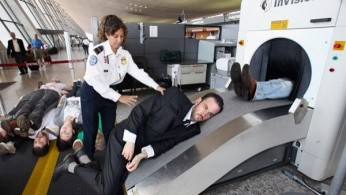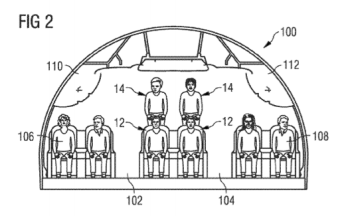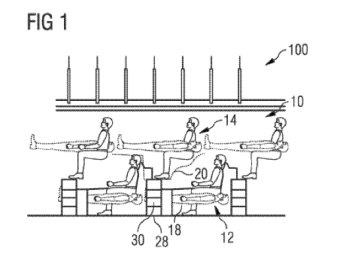By: Sarah Jessee,
If you have been on a plane recently you may have noticed the decreasing leg-room and shrinking seat width, but the seating changes may becoming more drastic.[1] On October 1, 2015 Airbus, a European aircraft manufacturer, filed a patent for stacked seating in airplanes.[2] The patent explained the justification for stacked seating and described the seating design proposal:
In modern means of transport, in particular aircraft, it is very important from an economic point of view to make optimum use of the available space in a passenger cabin… [i]n order to still more efficiently use the space in a passenger cabin of an aircraft, U.S. Pat. No. 4,066,227 proposes to position an elevated deck structure on a main deck floor in the passenger cabin of a wide-body aircraft for providing mezzanine seating area in a substantially unused upper lobe of the aircraft fuselage.[3]
Many concerns arise with the idea of stacked seating in an airplane. Is this “unused upper lobe” referring to the already limited space designated for carry-on items? How will flight attendants be able to assist those on the upper level? Are passengers expected to climb a ladder to get to their seats?[4] Most importantly, how could passengers be evacuated in case of an emergency? Despite the uncertainties and concerns with stacked seating, there are some possible benefits.
Other than reduced airline costs, the design proposal may actually create more legroom.[6] Many airplane passengers dread that moment the flight attendant comes on the speakers reporting they have reached the appropriate altitude and passengers can recline their seats. This reduces the already limited legroom. However, with Airbus’s stacked seating design, not only would passengers’ legroom increase when the passenger above you reclined, but passengers would be able to recline further.[7] The stacked seating design would allow passengers on both the upper and lower level to fully recline.[8] Despite these advantages, there are still concerns with space when the seats are in an upright position. [9]
However, we may never know how a flight attendant will deliver the after-dinner coffee to upper level passengers because this is one of the 600 patents Airbus files a year.[10] The company stated, “Airbus Group and its divisions apply for hundreds of patents every year in order to protect intellectual property… [t]he vast majority of items and processes patented never become fully realized technology or products.”[11] So whether you were excited or terrified by the idea, it is unlikely you will see yourself in a stacked airplane seat in the future.[12]
[1] Alison Griswold, New Airbus Patent Would Stack Passengers on Top of Each Other, Slate, Oct. 9, 2015, http://www.slate.com/blogs/moneybox/2015/10/09/airbus_files_patent_to_ stack_airline_passengers_on_top_of_each_other.html.
[2] U.S. Patent No. 4,066,227 (filed Oct. 1, 2015).
[3] Id.
[4] Hugo Martin, Are Stacked Seats the New Plan to Pack in Airline Passengers?, L.A. Times, Oct. 11, 2015, http://www.latimes.com/business/la-fi-are-stack-seats-the-next-trend-in-airline-seating-20151009-story.html.
[5] Suzy Strutner, These ‘Stacked’ Plane Seats Could End the Legroom Problem Forever, huffinton Post, Oct. 7, 2015, http://www.huffingtonpost.com/entry/airbus-stacked-seats_561509c7e4b0fad1591a1338.
[6] Id.
[7] Id.
[8] Id.
[9] Griswold, supra note 1.
[10] Strutner, supra note 5.
[11] Martin, supra note 4.
[12] Strutner, supra note 5.
Photo Source: http://i.onionstatic.com/onion/4365/16×9/600.jpg



